Edexcel BTEC HND Business: Pizza Hut Myanmar Business Plan Report
VerifiedAdded on 2022/02/05
|35
|10278
|636
Report
AI Summary
This report provides a detailed business plan for Pizza Hut Myanmar, encompassing an introduction to management and leadership fundamentals, a comprehensive business profile, and an analysis of the company's vision, mission, and objectives. It includes PESTLE and SWOT analyses, organizational structure, leadership styles, segmentation, targeting, and positioning (STP) strategies, and a detailed marketing mix (7Ps). The report also addresses controlling methods and concludes with recommendations and a reference list. The assignment uses various sources such as textbooks, journal articles, and websites to support the analysis and recommendations for Pizza Hut Myanmar's business plan for 2021.
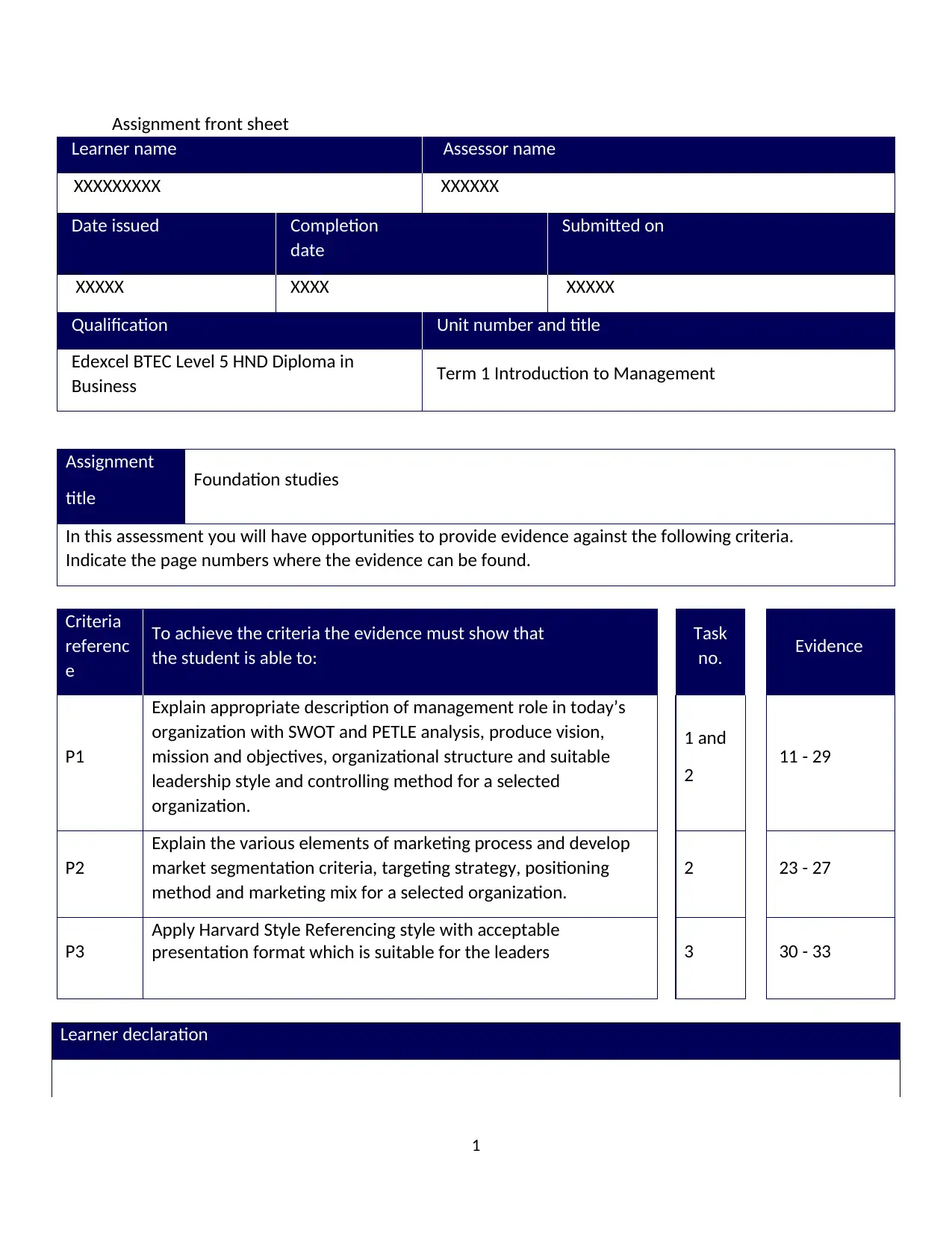
Assignment front sheet
Learner name Assessor name
XXXXXXXXX XXXXXX
Date issued Completion
date
Submitted on
XXXXX XXXX XXXXX
Qualification Unit number and title
Edexcel BTEC Level 5 HND Diploma in
Business Term 1 Introduction to Management
Assignment
title Foundation studies
In this assessment you will have opportunities to provide evidence against the following criteria.
Indicate the page numbers where the evidence can be found.
Criteria
referenc
e
To achieve the criteria the evidence must show that
the student is able to:
Task
no. Evidence
P1
Explain appropriate description of management role in today’s
organization with SWOT and PETLE analysis, produce vision,
mission and objectives, organizational structure and suitable
leadership style and controlling method for a selected
organization.
1 and
2 11 - 29
P2
Explain the various elements of marketing process and develop
market segmentation criteria, targeting strategy, positioning
method and marketing mix for a selected organization.
2 23 - 27
P3
Apply Harvard Style Referencing style with acceptable
presentation format which is suitable for the leaders 3 30 - 33
Learner declaration
1
Learner name Assessor name
XXXXXXXXX XXXXXX
Date issued Completion
date
Submitted on
XXXXX XXXX XXXXX
Qualification Unit number and title
Edexcel BTEC Level 5 HND Diploma in
Business Term 1 Introduction to Management
Assignment
title Foundation studies
In this assessment you will have opportunities to provide evidence against the following criteria.
Indicate the page numbers where the evidence can be found.
Criteria
referenc
e
To achieve the criteria the evidence must show that
the student is able to:
Task
no. Evidence
P1
Explain appropriate description of management role in today’s
organization with SWOT and PETLE analysis, produce vision,
mission and objectives, organizational structure and suitable
leadership style and controlling method for a selected
organization.
1 and
2 11 - 29
P2
Explain the various elements of marketing process and develop
market segmentation criteria, targeting strategy, positioning
method and marketing mix for a selected organization.
2 23 - 27
P3
Apply Harvard Style Referencing style with acceptable
presentation format which is suitable for the leaders 3 30 - 33
Learner declaration
1
Paraphrase This Document
Need a fresh take? Get an instant paraphrase of this document with our AI Paraphraser
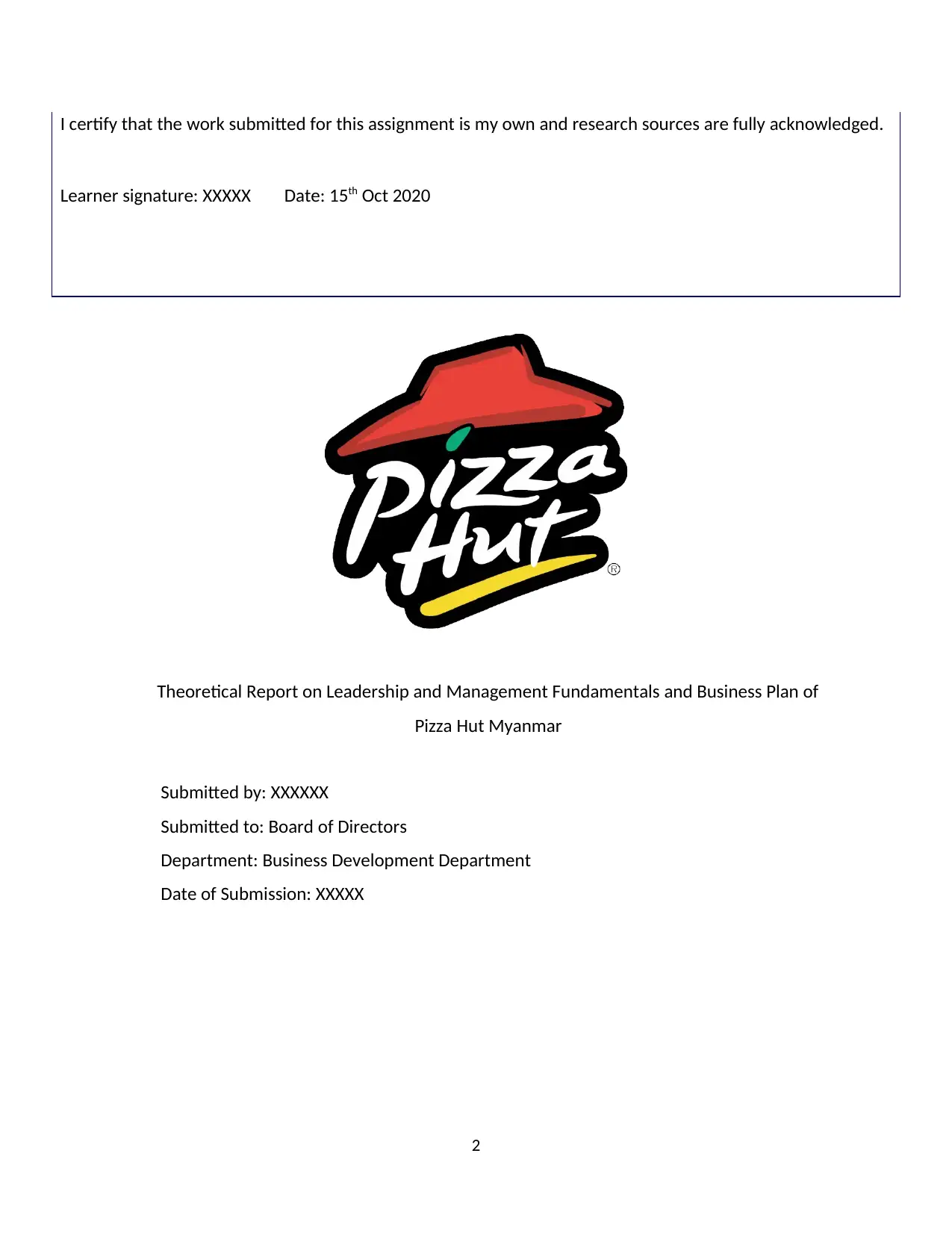
I certify that the work submitted for this assignment is my own and research sources are fully acknowledged.
Learner signature: XXXXX Date: 15th Oct 2020
Theoretical Report on Leadership and Management Fundamentals and Business Plan of
Pizza Hut Myanmar
Submitted by: XXXXXX
Submitted to: Board of Directors
Department: Business Development Department
Date of Submission: XXXXX
2
Learner signature: XXXXX Date: 15th Oct 2020
Theoretical Report on Leadership and Management Fundamentals and Business Plan of
Pizza Hut Myanmar
Submitted by: XXXXXX
Submitted to: Board of Directors
Department: Business Development Department
Date of Submission: XXXXX
2
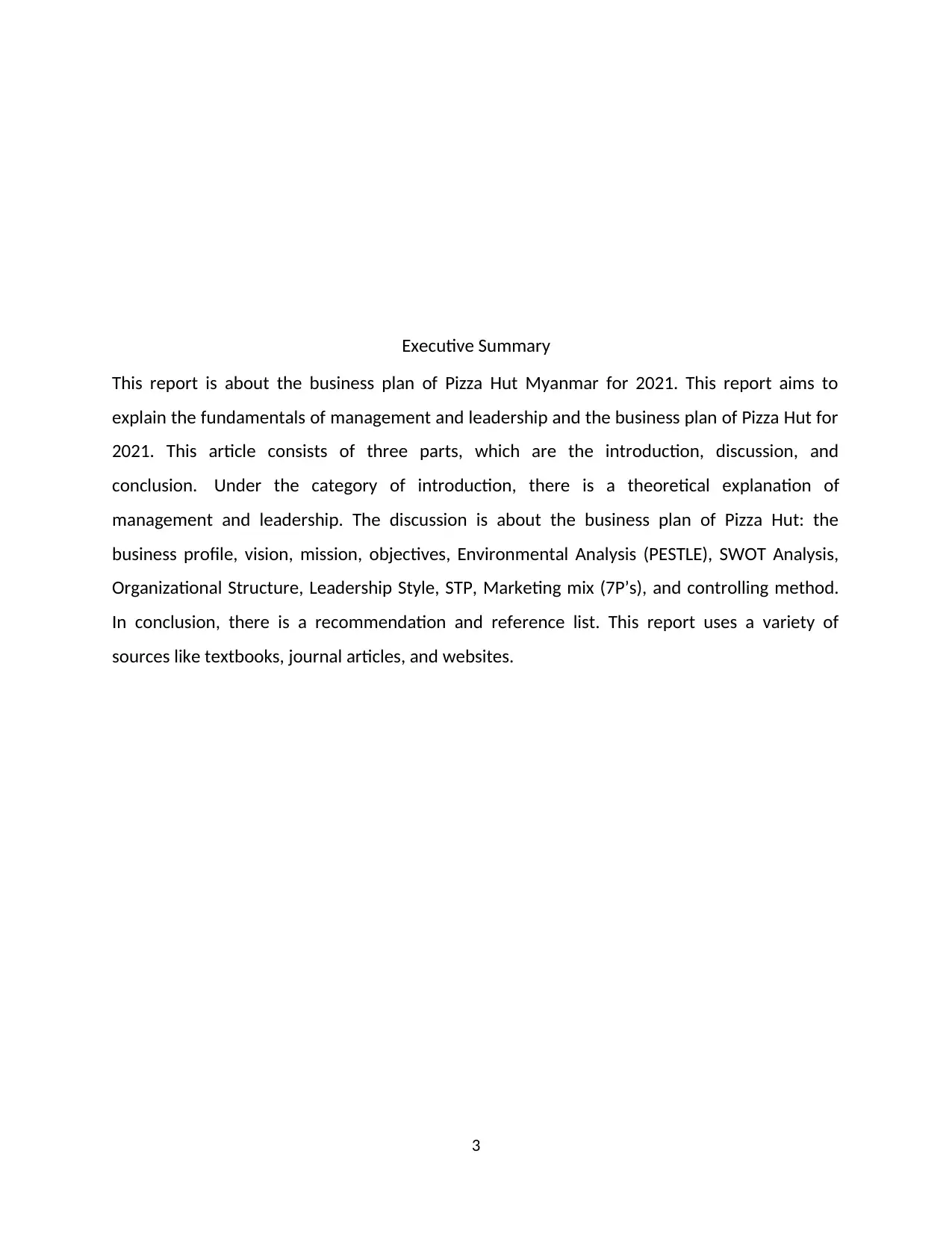
Executive Summary
This report is about the business plan of Pizza Hut Myanmar for 2021. This report aims to
explain the fundamentals of management and leadership and the business plan of Pizza Hut for
2021. This article consists of three parts, which are the introduction, discussion, and
conclusion. Under the category of introduction, there is a theoretical explanation of
management and leadership. The discussion is about the business plan of Pizza Hut: the
business profile, vision, mission, objectives, Environmental Analysis (PESTLE), SWOT Analysis,
Organizational Structure, Leadership Style, STP, Marketing mix (7P’s), and controlling method.
In conclusion, there is a recommendation and reference list. This report uses a variety of
sources like textbooks, journal articles, and websites.
3
This report is about the business plan of Pizza Hut Myanmar for 2021. This report aims to
explain the fundamentals of management and leadership and the business plan of Pizza Hut for
2021. This article consists of three parts, which are the introduction, discussion, and
conclusion. Under the category of introduction, there is a theoretical explanation of
management and leadership. The discussion is about the business plan of Pizza Hut: the
business profile, vision, mission, objectives, Environmental Analysis (PESTLE), SWOT Analysis,
Organizational Structure, Leadership Style, STP, Marketing mix (7P’s), and controlling method.
In conclusion, there is a recommendation and reference list. This report uses a variety of
sources like textbooks, journal articles, and websites.
3
⊘ This is a preview!⊘
Do you want full access?
Subscribe today to unlock all pages.

Trusted by 1+ million students worldwide
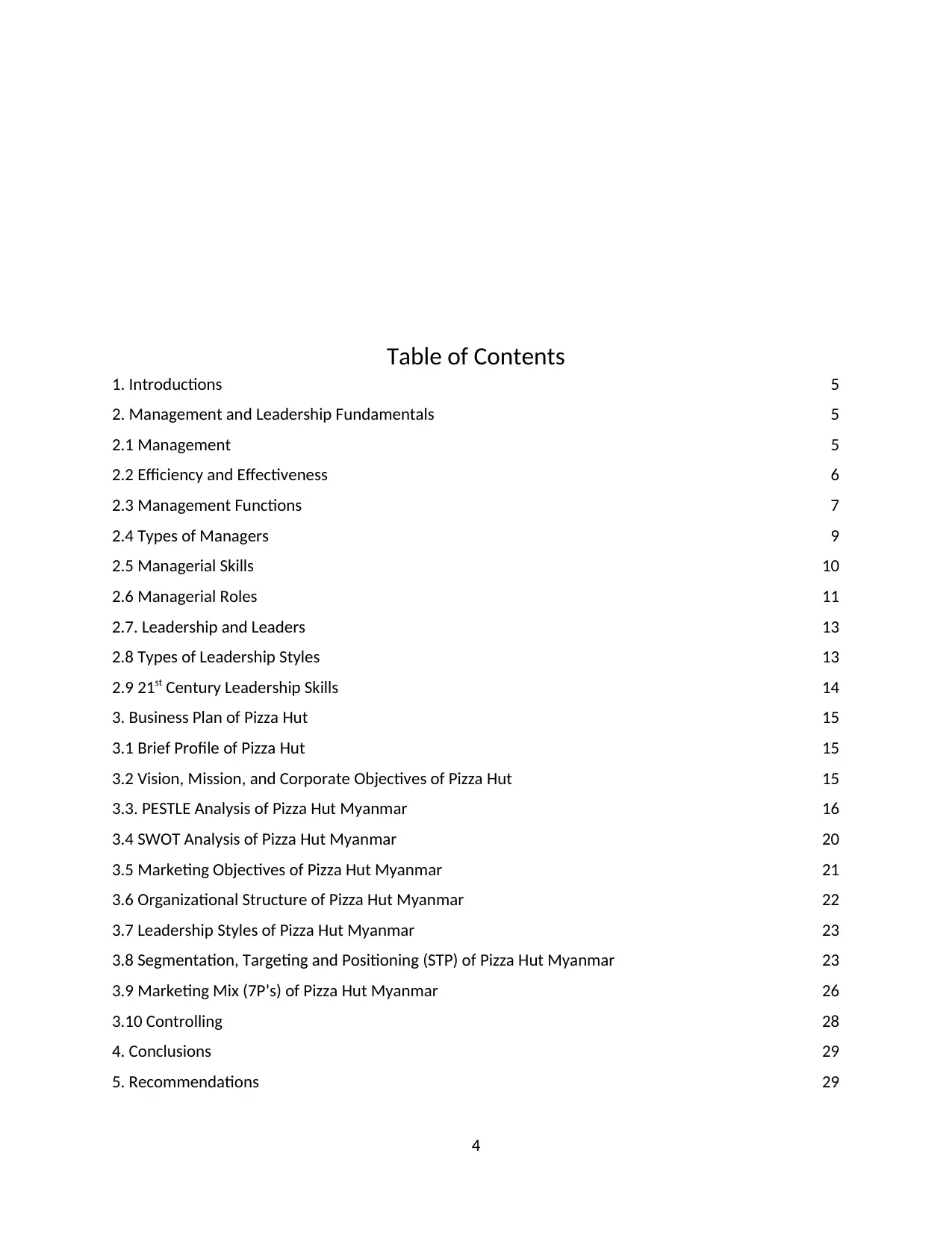
Table of Contents
1. Introductions 5
2. Management and Leadership Fundamentals 5
2.1 Management 5
2.2 Efficiency and Effectiveness 6
2.3 Management Functions 7
2.4 Types of Managers 9
2.5 Managerial Skills 10
2.6 Managerial Roles 11
2.7. Leadership and Leaders 13
2.8 Types of Leadership Styles 13
2.9 21st Century Leadership Skills 14
3. Business Plan of Pizza Hut 15
3.1 Brief Profile of Pizza Hut 15
3.2 Vision, Mission, and Corporate Objectives of Pizza Hut 15
3.3. PESTLE Analysis of Pizza Hut Myanmar 16
3.4 SWOT Analysis of Pizza Hut Myanmar 20
3.5 Marketing Objectives of Pizza Hut Myanmar 21
3.6 Organizational Structure of Pizza Hut Myanmar 22
3.7 Leadership Styles of Pizza Hut Myanmar 23
3.8 Segmentation, Targeting and Positioning (STP) of Pizza Hut Myanmar 23
3.9 Marketing Mix (7P’s) of Pizza Hut Myanmar 26
3.10 Controlling 28
4. Conclusions 29
5. Recommendations 29
4
1. Introductions 5
2. Management and Leadership Fundamentals 5
2.1 Management 5
2.2 Efficiency and Effectiveness 6
2.3 Management Functions 7
2.4 Types of Managers 9
2.5 Managerial Skills 10
2.6 Managerial Roles 11
2.7. Leadership and Leaders 13
2.8 Types of Leadership Styles 13
2.9 21st Century Leadership Skills 14
3. Business Plan of Pizza Hut 15
3.1 Brief Profile of Pizza Hut 15
3.2 Vision, Mission, and Corporate Objectives of Pizza Hut 15
3.3. PESTLE Analysis of Pizza Hut Myanmar 16
3.4 SWOT Analysis of Pizza Hut Myanmar 20
3.5 Marketing Objectives of Pizza Hut Myanmar 21
3.6 Organizational Structure of Pizza Hut Myanmar 22
3.7 Leadership Styles of Pizza Hut Myanmar 23
3.8 Segmentation, Targeting and Positioning (STP) of Pizza Hut Myanmar 23
3.9 Marketing Mix (7P’s) of Pizza Hut Myanmar 26
3.10 Controlling 28
4. Conclusions 29
5. Recommendations 29
4
Paraphrase This Document
Need a fresh take? Get an instant paraphrase of this document with our AI Paraphraser
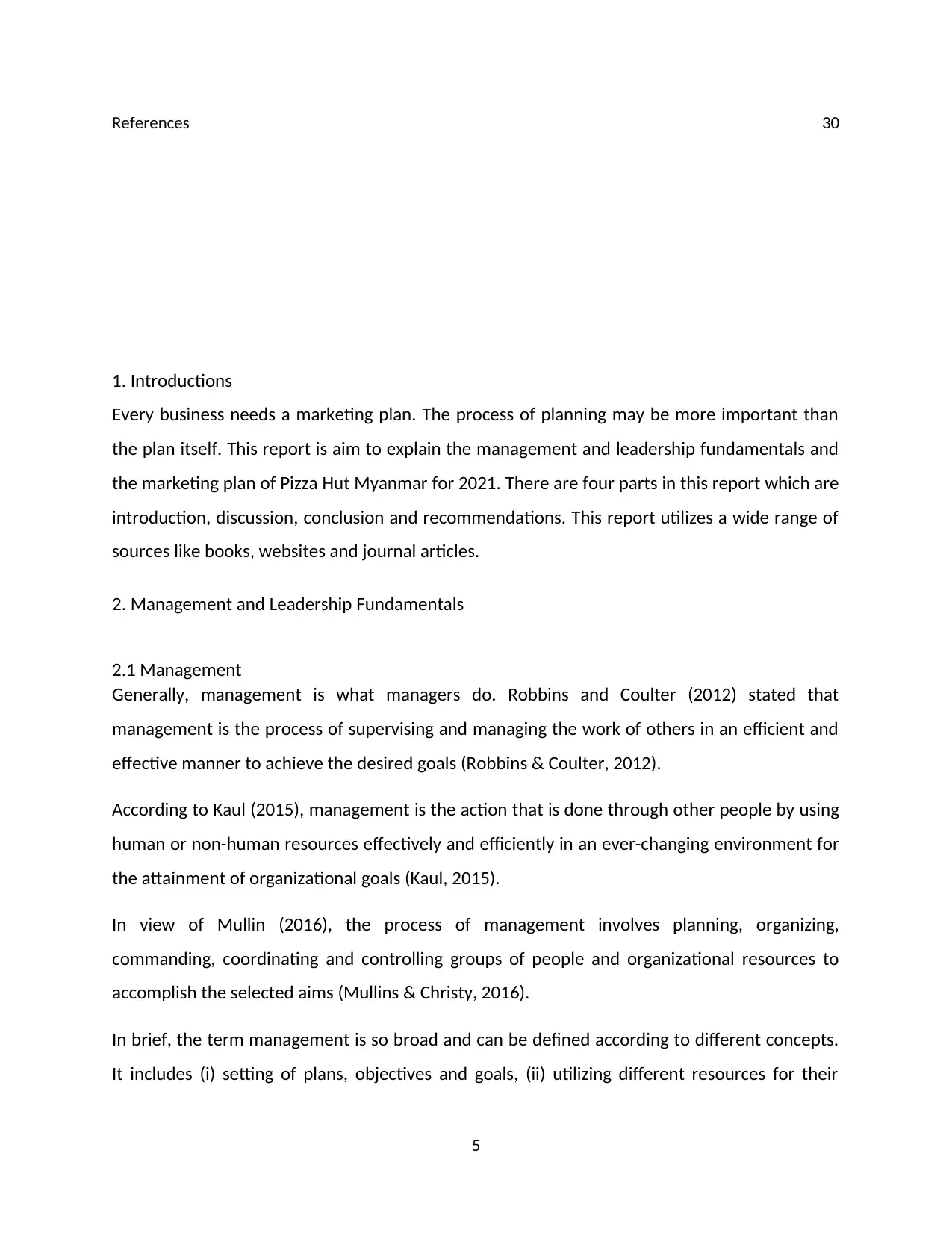
References 30
1. Introductions
Every business needs a marketing plan. The process of planning may be more important than
the plan itself. This report is aim to explain the management and leadership fundamentals and
the marketing plan of Pizza Hut Myanmar for 2021. There are four parts in this report which are
introduction, discussion, conclusion and recommendations. This report utilizes a wide range of
sources like books, websites and journal articles.
2. Management and Leadership Fundamentals
2.1 Management
Generally, management is what managers do. Robbins and Coulter (2012) stated that
management is the process of supervising and managing the work of others in an efficient and
effective manner to achieve the desired goals (Robbins & Coulter, 2012).
According to Kaul (2015), management is the action that is done through other people by using
human or non-human resources effectively and efficiently in an ever-changing environment for
the attainment of organizational goals (Kaul, 2015).
In view of Mullin (2016), the process of management involves planning, organizing,
commanding, coordinating and controlling groups of people and organizational resources to
accomplish the selected aims (Mullins & Christy, 2016).
In brief, the term management is so broad and can be defined according to different concepts.
It includes (i) setting of plans, objectives and goals, (ii) utilizing different resources for their
5
1. Introductions
Every business needs a marketing plan. The process of planning may be more important than
the plan itself. This report is aim to explain the management and leadership fundamentals and
the marketing plan of Pizza Hut Myanmar for 2021. There are four parts in this report which are
introduction, discussion, conclusion and recommendations. This report utilizes a wide range of
sources like books, websites and journal articles.
2. Management and Leadership Fundamentals
2.1 Management
Generally, management is what managers do. Robbins and Coulter (2012) stated that
management is the process of supervising and managing the work of others in an efficient and
effective manner to achieve the desired goals (Robbins & Coulter, 2012).
According to Kaul (2015), management is the action that is done through other people by using
human or non-human resources effectively and efficiently in an ever-changing environment for
the attainment of organizational goals (Kaul, 2015).
In view of Mullin (2016), the process of management involves planning, organizing,
commanding, coordinating and controlling groups of people and organizational resources to
accomplish the selected aims (Mullins & Christy, 2016).
In brief, the term management is so broad and can be defined according to different concepts.
It includes (i) setting of plans, objectives and goals, (ii) utilizing different resources for their
5
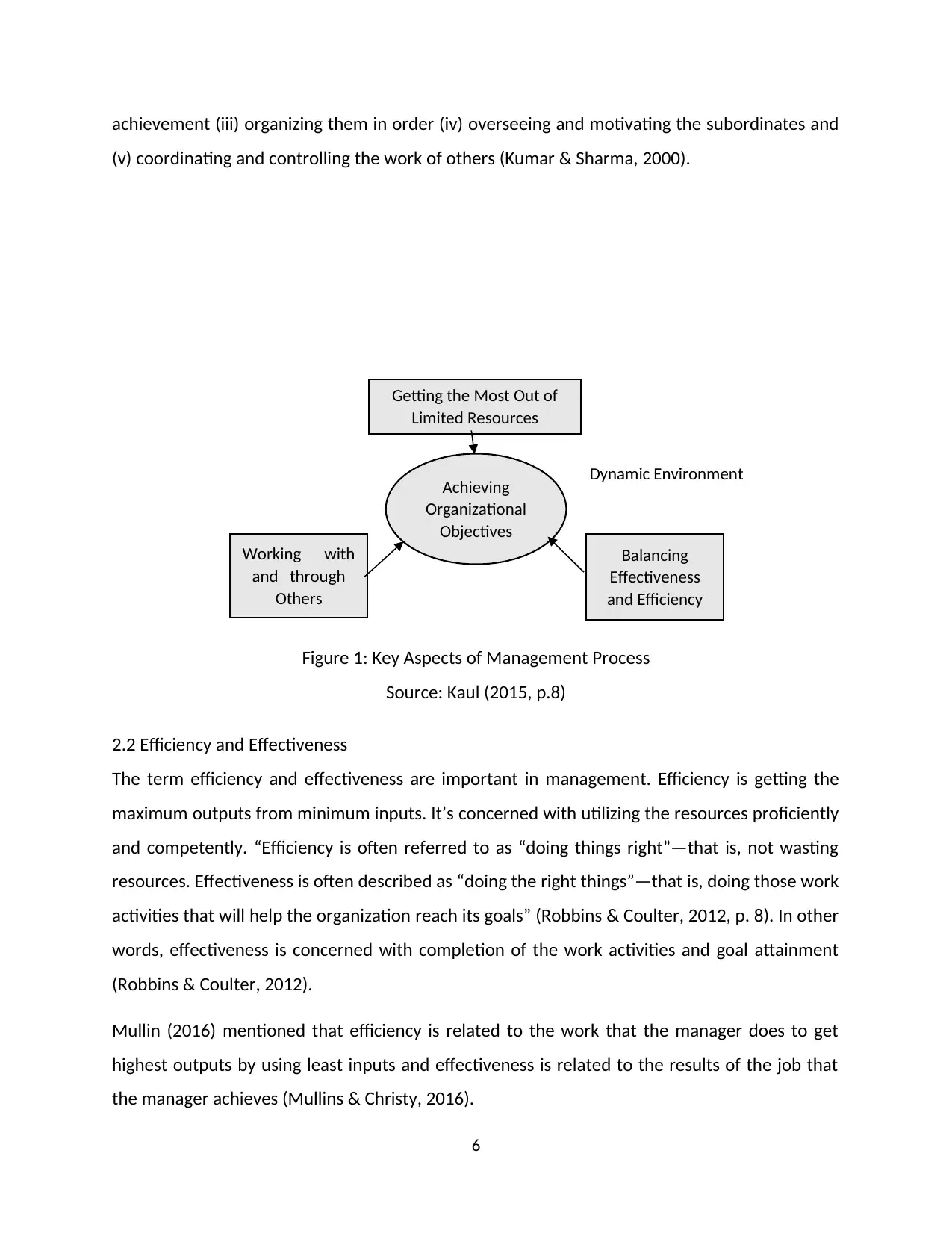
achievement (iii) organizing them in order (iv) overseeing and motivating the subordinates and
(v) coordinating and controlling the work of others (Kumar & Sharma, 2000).
Dynamic Environment
Figure 1: Key Aspects of Management Process
Source: Kaul (2015, p.8)
2.2 Efficiency and Effectiveness
The term efficiency and effectiveness are important in management. Efficiency is getting the
maximum outputs from minimum inputs. It’s concerned with utilizing the resources proficiently
and competently. “Efficiency is often referred to as “doing things right”—that is, not wasting
resources. Effectiveness is often described as “doing the right things”—that is, doing those work
activities that will help the organization reach its goals” (Robbins & Coulter, 2012, p. 8). In other
words, effectiveness is concerned with completion of the work activities and goal attainment
(Robbins & Coulter, 2012).
Mullin (2016) mentioned that efficiency is related to the work that the manager does to get
highest outputs by using least inputs and effectiveness is related to the results of the job that
the manager achieves (Mullins & Christy, 2016).
6
Getting the Most Out of
Limited Resources
Achieving
Organizational
Objectives
Working with
and through
Others
Balancing
Effectiveness
and Efficiency
(v) coordinating and controlling the work of others (Kumar & Sharma, 2000).
Dynamic Environment
Figure 1: Key Aspects of Management Process
Source: Kaul (2015, p.8)
2.2 Efficiency and Effectiveness
The term efficiency and effectiveness are important in management. Efficiency is getting the
maximum outputs from minimum inputs. It’s concerned with utilizing the resources proficiently
and competently. “Efficiency is often referred to as “doing things right”—that is, not wasting
resources. Effectiveness is often described as “doing the right things”—that is, doing those work
activities that will help the organization reach its goals” (Robbins & Coulter, 2012, p. 8). In other
words, effectiveness is concerned with completion of the work activities and goal attainment
(Robbins & Coulter, 2012).
Mullin (2016) mentioned that efficiency is related to the work that the manager does to get
highest outputs by using least inputs and effectiveness is related to the results of the job that
the manager achieves (Mullins & Christy, 2016).
6
Getting the Most Out of
Limited Resources
Achieving
Organizational
Objectives
Working with
and through
Others
Balancing
Effectiveness
and Efficiency
⊘ This is a preview!⊘
Do you want full access?
Subscribe today to unlock all pages.

Trusted by 1+ million students worldwide
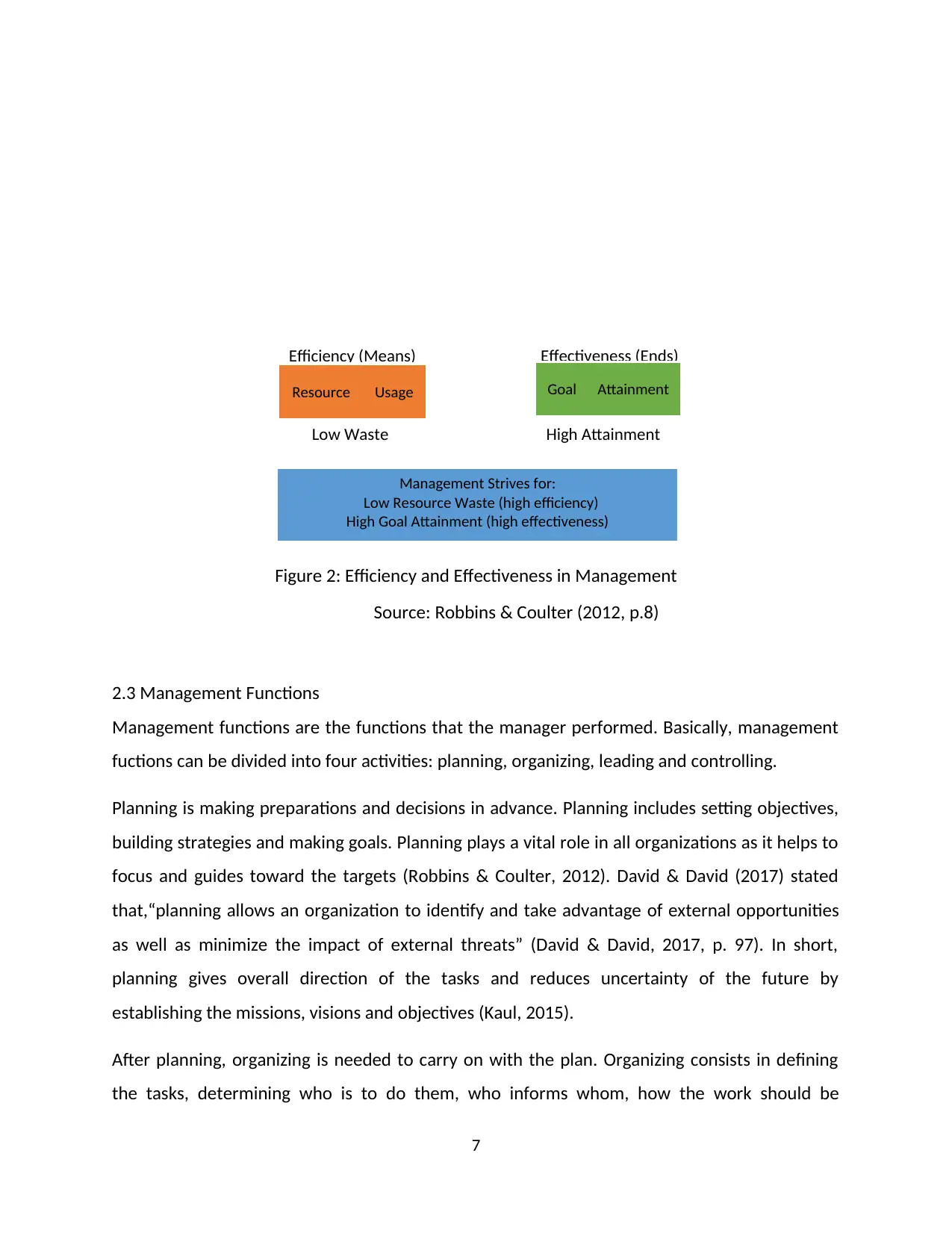
Efficiency (Means) Effectiveness (Ends)
Low Waste High Attainment
Figure 2: Efficiency and Effectiveness in Management
Source: Robbins & Coulter (2012, p.8)
2.3 Management Functions
Management functions are the functions that the manager performed. Basically, management
fuctions can be divided into four activities: planning, organizing, leading and controlling.
Planning is making preparations and decisions in advance. Planning includes setting objectives,
building strategies and making goals. Planning plays a vital role in all organizations as it helps to
focus and guides toward the targets (Robbins & Coulter, 2012). David & David (2017) stated
that,“planning allows an organization to identify and take advantage of external opportunities
as well as minimize the impact of external threats” (David & David, 2017, p. 97). In short,
planning gives overall direction of the tasks and reduces uncertainty of the future by
establishing the missions, visions and objectives (Kaul, 2015).
After planning, organizing is needed to carry on with the plan. Organizing consists in defining
the tasks, determining who is to do them, who informs whom, how the work should be
7
Resource Usage Goal Attainment
Management Strives for:
Low Resource Waste (high efficiency)
High Goal Attainment (high effectiveness)
Low Waste High Attainment
Figure 2: Efficiency and Effectiveness in Management
Source: Robbins & Coulter (2012, p.8)
2.3 Management Functions
Management functions are the functions that the manager performed. Basically, management
fuctions can be divided into four activities: planning, organizing, leading and controlling.
Planning is making preparations and decisions in advance. Planning includes setting objectives,
building strategies and making goals. Planning plays a vital role in all organizations as it helps to
focus and guides toward the targets (Robbins & Coulter, 2012). David & David (2017) stated
that,“planning allows an organization to identify and take advantage of external opportunities
as well as minimize the impact of external threats” (David & David, 2017, p. 97). In short,
planning gives overall direction of the tasks and reduces uncertainty of the future by
establishing the missions, visions and objectives (Kaul, 2015).
After planning, organizing is needed to carry on with the plan. Organizing consists in defining
the tasks, determining who is to do them, who informs whom, how the work should be
7
Resource Usage Goal Attainment
Management Strives for:
Low Resource Waste (high efficiency)
High Goal Attainment (high effectiveness)
Paraphrase This Document
Need a fresh take? Get an instant paraphrase of this document with our AI Paraphraser
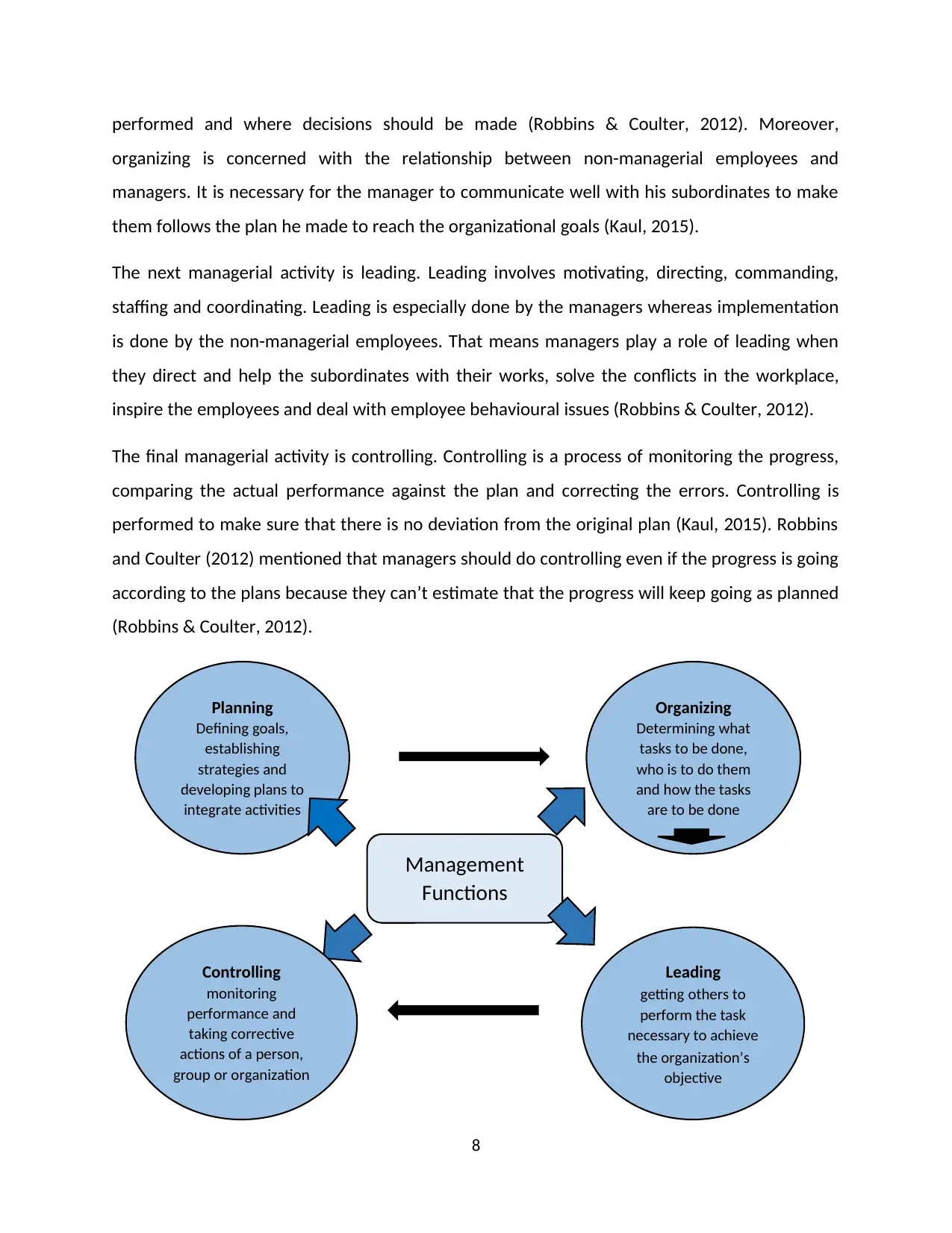
performed and where decisions should be made (Robbins & Coulter, 2012). Moreover,
organizing is concerned with the relationship between non-managerial employees and
managers. It is necessary for the manager to communicate well with his subordinates to make
them follows the plan he made to reach the organizational goals (Kaul, 2015).
The next managerial activity is leading. Leading involves motivating, directing, commanding,
staffing and coordinating. Leading is especially done by the managers whereas implementation
is done by the non-managerial employees. That means managers play a role of leading when
they direct and help the subordinates with their works, solve the conflicts in the workplace,
inspire the employees and deal with employee behavioural issues (Robbins & Coulter, 2012).
The final managerial activity is controlling. Controlling is a process of monitoring the progress,
comparing the actual performance against the plan and correcting the errors. Controlling is
performed to make sure that there is no deviation from the original plan (Kaul, 2015). Robbins
and Coulter (2012) mentioned that managers should do controlling even if the progress is going
according to the plans because they can’t estimate that the progress will keep going as planned
(Robbins & Coulter, 2012).
8
Planning
Defining goals,
establishing
strategies and
developing plans to
integrate activities
Organizing
Determining what
tasks to be done,
who is to do them
and how the tasks
are to be done
Management
Functions
Leading
getting others to
perform the task
necessary to achieve
the organization’s
objective
Controlling
monitoring
performance and
taking corrective
actions of a person,
group or organization
organizing is concerned with the relationship between non-managerial employees and
managers. It is necessary for the manager to communicate well with his subordinates to make
them follows the plan he made to reach the organizational goals (Kaul, 2015).
The next managerial activity is leading. Leading involves motivating, directing, commanding,
staffing and coordinating. Leading is especially done by the managers whereas implementation
is done by the non-managerial employees. That means managers play a role of leading when
they direct and help the subordinates with their works, solve the conflicts in the workplace,
inspire the employees and deal with employee behavioural issues (Robbins & Coulter, 2012).
The final managerial activity is controlling. Controlling is a process of monitoring the progress,
comparing the actual performance against the plan and correcting the errors. Controlling is
performed to make sure that there is no deviation from the original plan (Kaul, 2015). Robbins
and Coulter (2012) mentioned that managers should do controlling even if the progress is going
according to the plans because they can’t estimate that the progress will keep going as planned
(Robbins & Coulter, 2012).
8
Planning
Defining goals,
establishing
strategies and
developing plans to
integrate activities
Organizing
Determining what
tasks to be done,
who is to do them
and how the tasks
are to be done
Management
Functions
Leading
getting others to
perform the task
necessary to achieve
the organization’s
objective
Controlling
monitoring
performance and
taking corrective
actions of a person,
group or organization
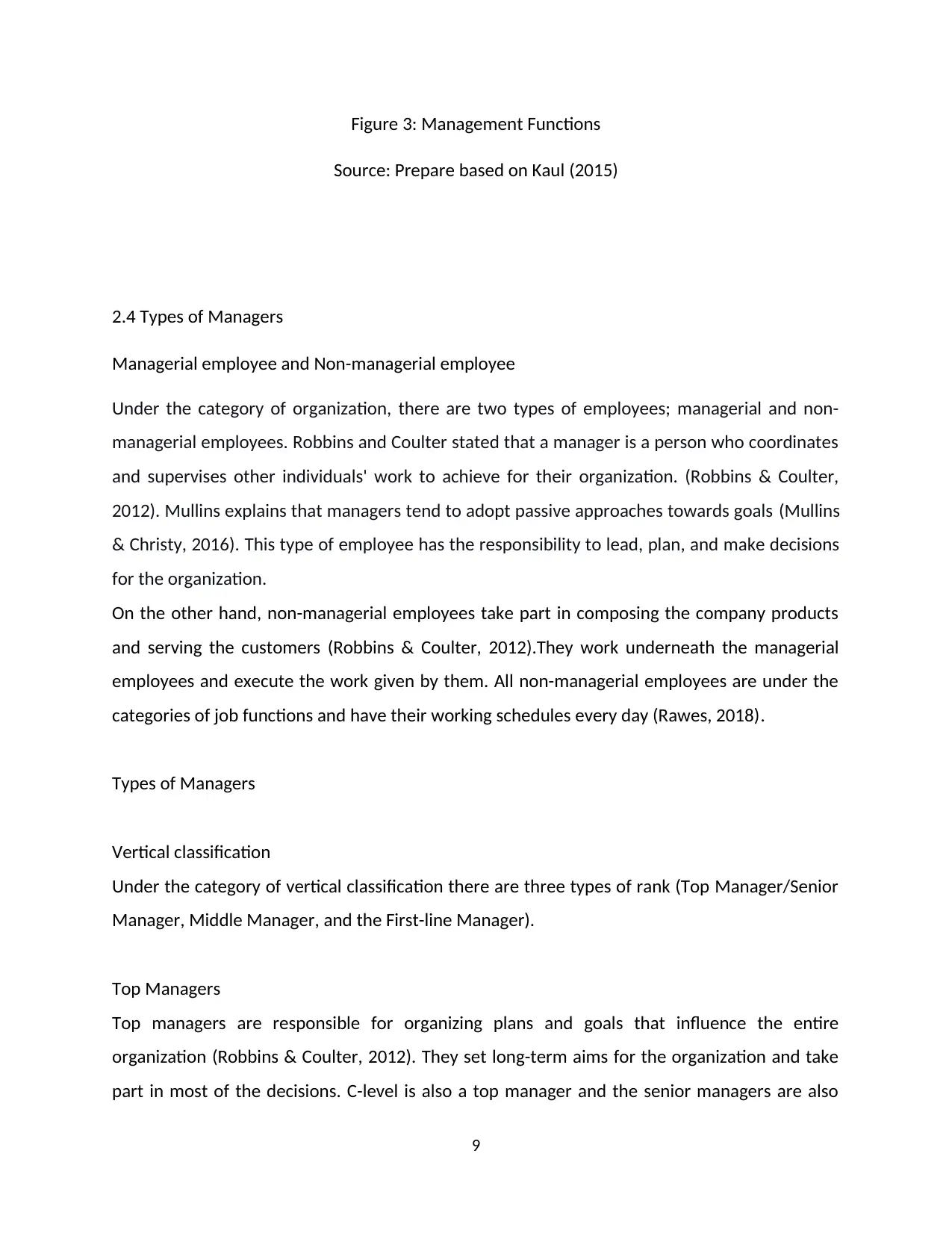
Figure 3: Management Functions
Source: Prepare based on Kaul (2015)
2.4 Types of Managers
Managerial employee and Non-managerial employee
Under the category of organization, there are two types of employees; managerial and non-
managerial employees. Robbins and Coulter stated that a manager is a person who coordinates
and supervises other individuals' work to achieve for their organization. (Robbins & Coulter,
2012). Mullins explains that managers tend to adopt passive approaches towards goals (Mullins
& Christy, 2016). This type of employee has the responsibility to lead, plan, and make decisions
for the organization.
On the other hand, non-managerial employees take part in composing the company products
and serving the customers (Robbins & Coulter, 2012).They work underneath the managerial
employees and execute the work given by them. All non-managerial employees are under the
categories of job functions and have their working schedules every day (Rawes, 2018).
Types of Managers
Vertical classification
Under the category of vertical classification there are three types of rank (Top Manager/Senior
Manager, Middle Manager, and the First-line Manager).
Top Managers
Top managers are responsible for organizing plans and goals that influence the entire
organization (Robbins & Coulter, 2012). They set long-term aims for the organization and take
part in most of the decisions. C-level is also a top manager and the senior managers are also
9
Source: Prepare based on Kaul (2015)
2.4 Types of Managers
Managerial employee and Non-managerial employee
Under the category of organization, there are two types of employees; managerial and non-
managerial employees. Robbins and Coulter stated that a manager is a person who coordinates
and supervises other individuals' work to achieve for their organization. (Robbins & Coulter,
2012). Mullins explains that managers tend to adopt passive approaches towards goals (Mullins
& Christy, 2016). This type of employee has the responsibility to lead, plan, and make decisions
for the organization.
On the other hand, non-managerial employees take part in composing the company products
and serving the customers (Robbins & Coulter, 2012).They work underneath the managerial
employees and execute the work given by them. All non-managerial employees are under the
categories of job functions and have their working schedules every day (Rawes, 2018).
Types of Managers
Vertical classification
Under the category of vertical classification there are three types of rank (Top Manager/Senior
Manager, Middle Manager, and the First-line Manager).
Top Managers
Top managers are responsible for organizing plans and goals that influence the entire
organization (Robbins & Coulter, 2012). They set long-term aims for the organization and take
part in most of the decisions. C-level is also a top manager and the senior managers are also
9
⊘ This is a preview!⊘
Do you want full access?
Subscribe today to unlock all pages.

Trusted by 1+ million students worldwide
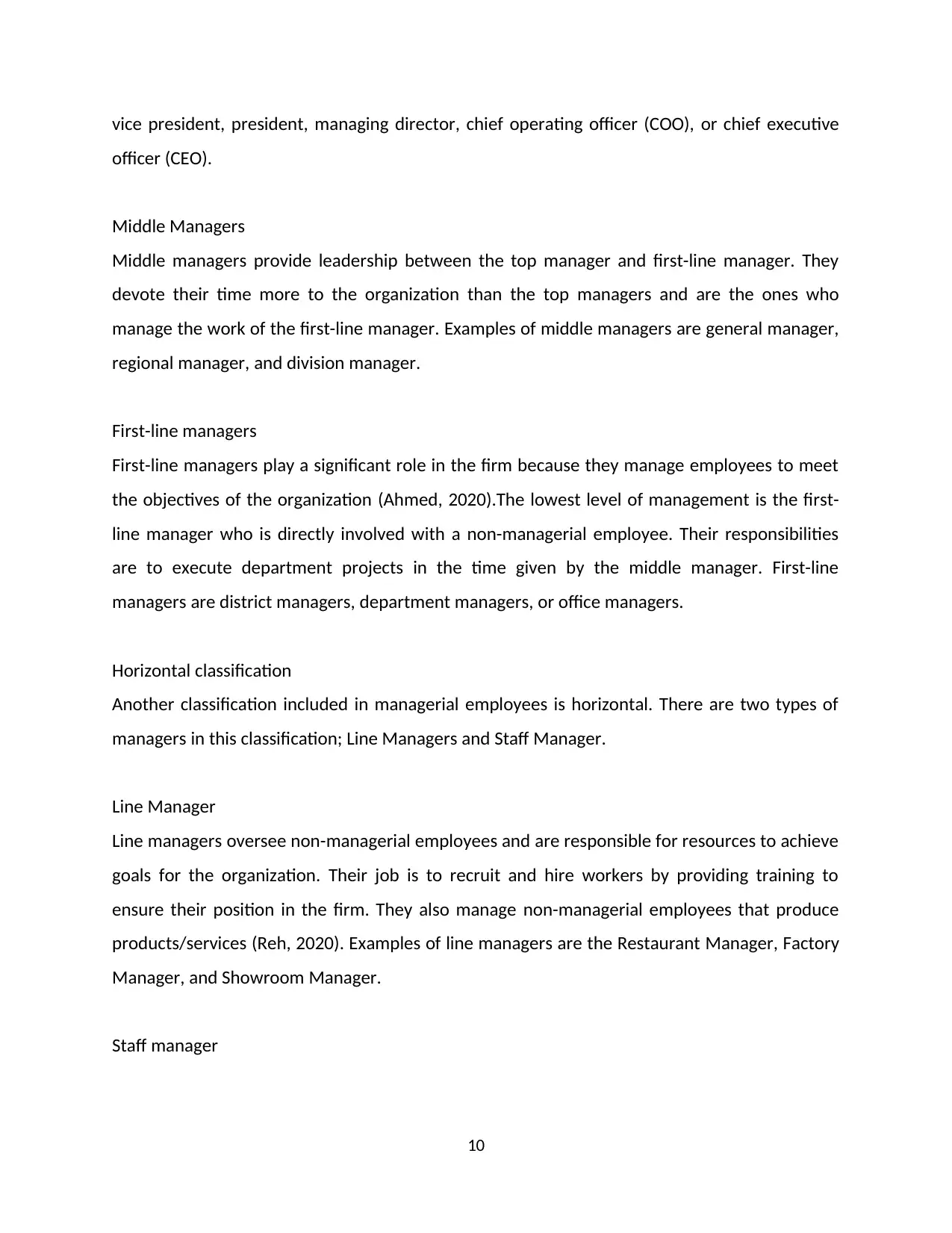
vice president, president, managing director, chief operating officer (COO), or chief executive
officer (CEO).
Middle Managers
Middle managers provide leadership between the top manager and first-line manager. They
devote their time more to the organization than the top managers and are the ones who
manage the work of the first-line manager. Examples of middle managers are general manager,
regional manager, and division manager.
First-line managers
First-line managers play a significant role in the firm because they manage employees to meet
the objectives of the organization (Ahmed, 2020).The lowest level of management is the first-
line manager who is directly involved with a non-managerial employee. Their responsibilities
are to execute department projects in the time given by the middle manager. First-line
managers are district managers, department managers, or office managers.
Horizontal classification
Another classification included in managerial employees is horizontal. There are two types of
managers in this classification; Line Managers and Staff Manager.
Line Manager
Line managers oversee non-managerial employees and are responsible for resources to achieve
goals for the organization. Their job is to recruit and hire workers by providing training to
ensure their position in the firm. They also manage non-managerial employees that produce
products/services (Reh, 2020). Examples of line managers are the Restaurant Manager, Factory
Manager, and Showroom Manager.
Staff manager
10
officer (CEO).
Middle Managers
Middle managers provide leadership between the top manager and first-line manager. They
devote their time more to the organization than the top managers and are the ones who
manage the work of the first-line manager. Examples of middle managers are general manager,
regional manager, and division manager.
First-line managers
First-line managers play a significant role in the firm because they manage employees to meet
the objectives of the organization (Ahmed, 2020).The lowest level of management is the first-
line manager who is directly involved with a non-managerial employee. Their responsibilities
are to execute department projects in the time given by the middle manager. First-line
managers are district managers, department managers, or office managers.
Horizontal classification
Another classification included in managerial employees is horizontal. There are two types of
managers in this classification; Line Managers and Staff Manager.
Line Manager
Line managers oversee non-managerial employees and are responsible for resources to achieve
goals for the organization. Their job is to recruit and hire workers by providing training to
ensure their position in the firm. They also manage non-managerial employees that produce
products/services (Reh, 2020). Examples of line managers are the Restaurant Manager, Factory
Manager, and Showroom Manager.
Staff manager
10
Paraphrase This Document
Need a fresh take? Get an instant paraphrase of this document with our AI Paraphraser
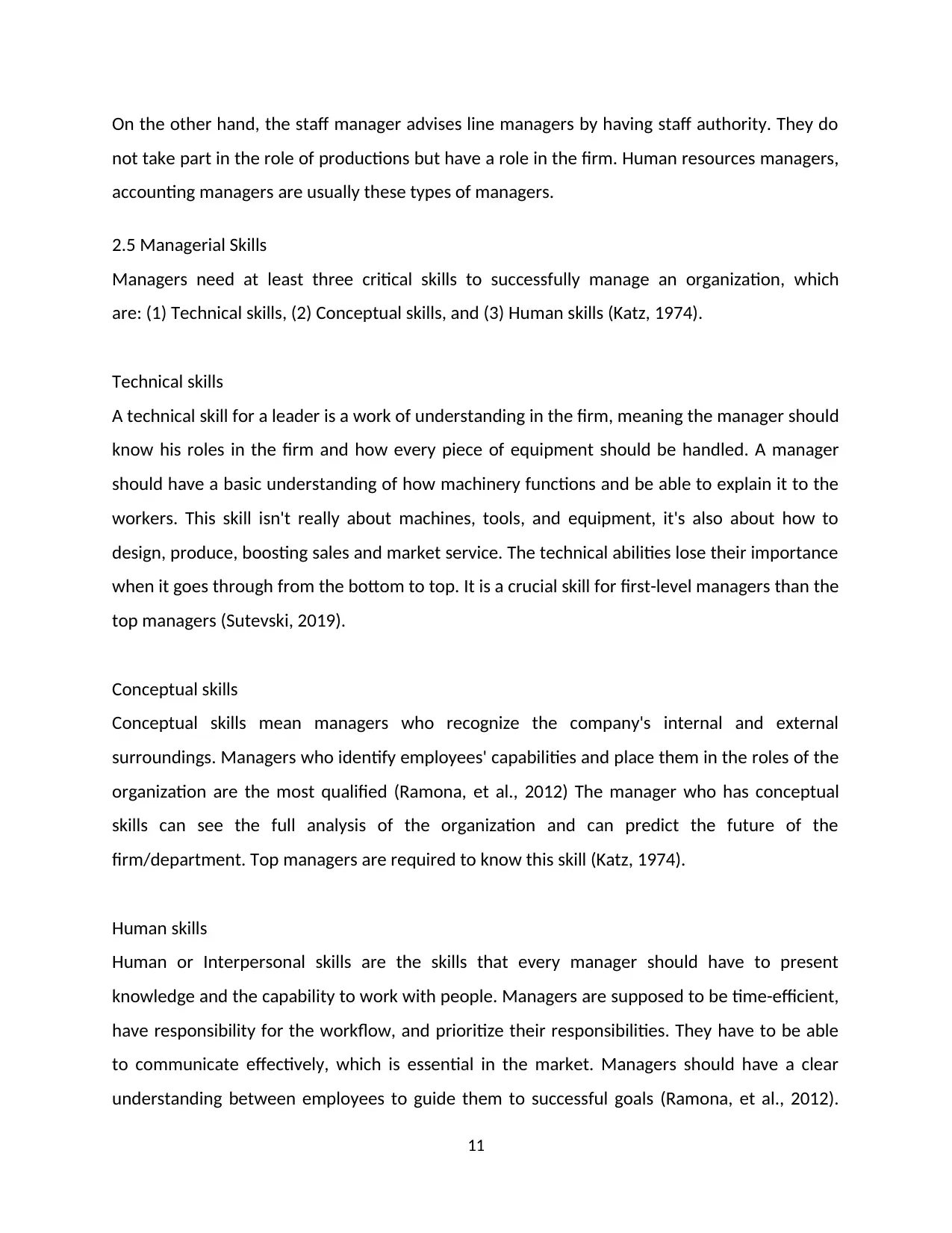
On the other hand, the staff manager advises line managers by having staff authority. They do
not take part in the role of productions but have a role in the firm. Human resources managers,
accounting managers are usually these types of managers.
2.5 Managerial Skills
Managers need at least three critical skills to successfully manage an organization, which
are: (1) Technical skills, (2) Conceptual skills, and (3) Human skills (Katz, 1974).
Technical skills
A technical skill for a leader is a work of understanding in the firm, meaning the manager should
know his roles in the firm and how every piece of equipment should be handled. A manager
should have a basic understanding of how machinery functions and be able to explain it to the
workers. This skill isn't really about machines, tools, and equipment, it's also about how to
design, produce, boosting sales and market service. The technical abilities lose their importance
when it goes through from the bottom to top. It is a crucial skill for first-level managers than the
top managers (Sutevski, 2019).
Conceptual skills
Conceptual skills mean managers who recognize the company's internal and external
surroundings. Managers who identify employees' capabilities and place them in the roles of the
organization are the most qualified (Ramona, et al., 2012) The manager who has conceptual
skills can see the full analysis of the organization and can predict the future of the
firm/department. Top managers are required to know this skill (Katz, 1974).
Human skills
Human or Interpersonal skills are the skills that every manager should have to present
knowledge and the capability to work with people. Managers are supposed to be time-efficient,
have responsibility for the workflow, and prioritize their responsibilities. They have to be able
to communicate effectively, which is essential in the market. Managers should have a clear
understanding between employees to guide them to successful goals (Ramona, et al., 2012).
11
not take part in the role of productions but have a role in the firm. Human resources managers,
accounting managers are usually these types of managers.
2.5 Managerial Skills
Managers need at least three critical skills to successfully manage an organization, which
are: (1) Technical skills, (2) Conceptual skills, and (3) Human skills (Katz, 1974).
Technical skills
A technical skill for a leader is a work of understanding in the firm, meaning the manager should
know his roles in the firm and how every piece of equipment should be handled. A manager
should have a basic understanding of how machinery functions and be able to explain it to the
workers. This skill isn't really about machines, tools, and equipment, it's also about how to
design, produce, boosting sales and market service. The technical abilities lose their importance
when it goes through from the bottom to top. It is a crucial skill for first-level managers than the
top managers (Sutevski, 2019).
Conceptual skills
Conceptual skills mean managers who recognize the company's internal and external
surroundings. Managers who identify employees' capabilities and place them in the roles of the
organization are the most qualified (Ramona, et al., 2012) The manager who has conceptual
skills can see the full analysis of the organization and can predict the future of the
firm/department. Top managers are required to know this skill (Katz, 1974).
Human skills
Human or Interpersonal skills are the skills that every manager should have to present
knowledge and the capability to work with people. Managers are supposed to be time-efficient,
have responsibility for the workflow, and prioritize their responsibilities. They have to be able
to communicate effectively, which is essential in the market. Managers should have a clear
understanding between employees to guide them to successful goals (Ramona, et al., 2012).
11
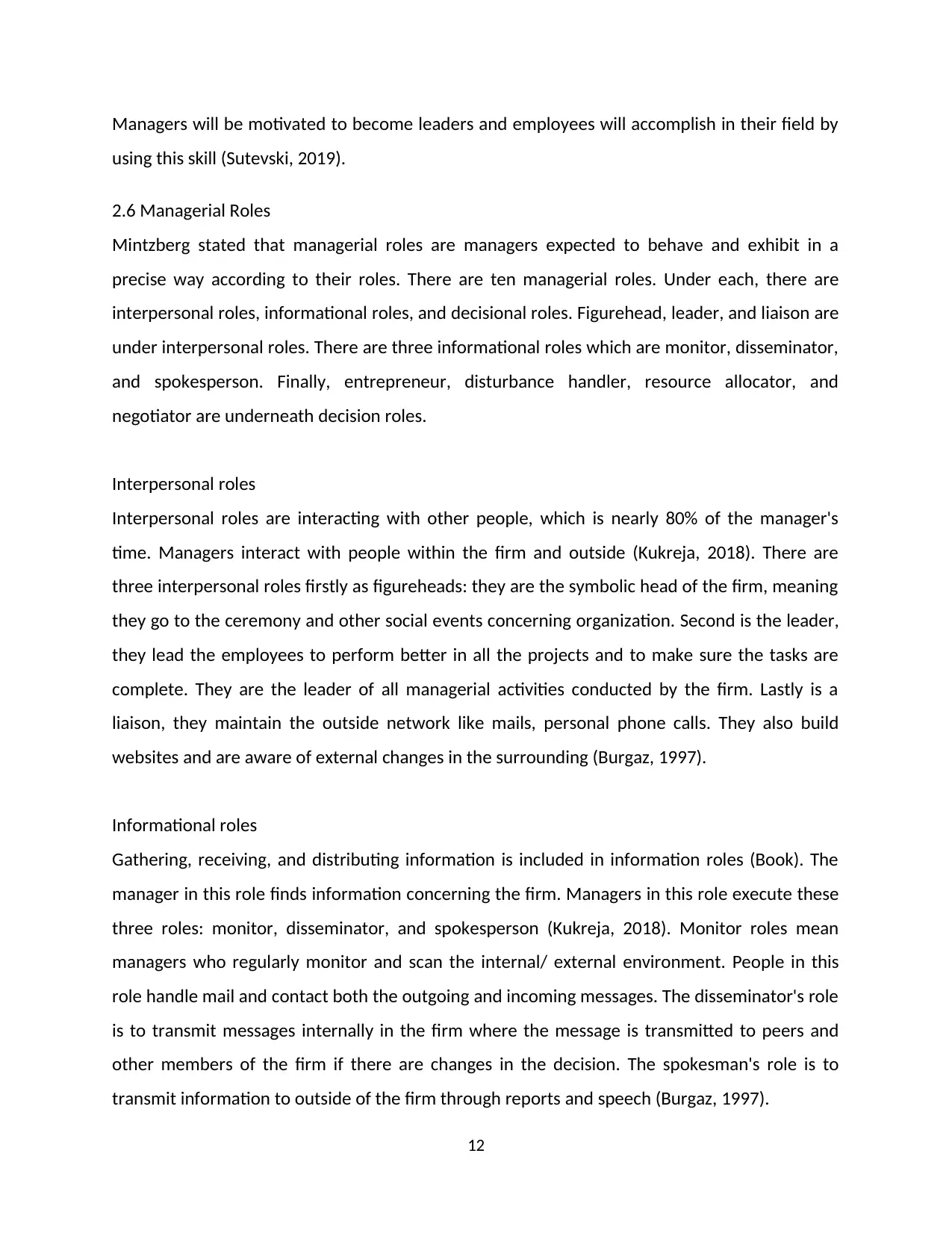
Managers will be motivated to become leaders and employees will accomplish in their field by
using this skill (Sutevski, 2019).
2.6 Managerial Roles
Mintzberg stated that managerial roles are managers expected to behave and exhibit in a
precise way according to their roles. There are ten managerial roles. Under each, there are
interpersonal roles, informational roles, and decisional roles. Figurehead, leader, and liaison are
under interpersonal roles. There are three informational roles which are monitor, disseminator,
and spokesperson. Finally, entrepreneur, disturbance handler, resource allocator, and
negotiator are underneath decision roles.
Interpersonal roles
Interpersonal roles are interacting with other people, which is nearly 80% of the manager's
time. Managers interact with people within the firm and outside (Kukreja, 2018). There are
three interpersonal roles firstly as figureheads: they are the symbolic head of the firm, meaning
they go to the ceremony and other social events concerning organization. Second is the leader,
they lead the employees to perform better in all the projects and to make sure the tasks are
complete. They are the leader of all managerial activities conducted by the firm. Lastly is a
liaison, they maintain the outside network like mails, personal phone calls. They also build
websites and are aware of external changes in the surrounding (Burgaz, 1997).
Informational roles
Gathering, receiving, and distributing information is included in information roles (Book). The
manager in this role finds information concerning the firm. Managers in this role execute these
three roles: monitor, disseminator, and spokesperson (Kukreja, 2018). Monitor roles mean
managers who regularly monitor and scan the internal/ external environment. People in this
role handle mail and contact both the outgoing and incoming messages. The disseminator's role
is to transmit messages internally in the firm where the message is transmitted to peers and
other members of the firm if there are changes in the decision. The spokesman's role is to
transmit information to outside of the firm through reports and speech (Burgaz, 1997).
12
using this skill (Sutevski, 2019).
2.6 Managerial Roles
Mintzberg stated that managerial roles are managers expected to behave and exhibit in a
precise way according to their roles. There are ten managerial roles. Under each, there are
interpersonal roles, informational roles, and decisional roles. Figurehead, leader, and liaison are
under interpersonal roles. There are three informational roles which are monitor, disseminator,
and spokesperson. Finally, entrepreneur, disturbance handler, resource allocator, and
negotiator are underneath decision roles.
Interpersonal roles
Interpersonal roles are interacting with other people, which is nearly 80% of the manager's
time. Managers interact with people within the firm and outside (Kukreja, 2018). There are
three interpersonal roles firstly as figureheads: they are the symbolic head of the firm, meaning
they go to the ceremony and other social events concerning organization. Second is the leader,
they lead the employees to perform better in all the projects and to make sure the tasks are
complete. They are the leader of all managerial activities conducted by the firm. Lastly is a
liaison, they maintain the outside network like mails, personal phone calls. They also build
websites and are aware of external changes in the surrounding (Burgaz, 1997).
Informational roles
Gathering, receiving, and distributing information is included in information roles (Book). The
manager in this role finds information concerning the firm. Managers in this role execute these
three roles: monitor, disseminator, and spokesperson (Kukreja, 2018). Monitor roles mean
managers who regularly monitor and scan the internal/ external environment. People in this
role handle mail and contact both the outgoing and incoming messages. The disseminator's role
is to transmit messages internally in the firm where the message is transmitted to peers and
other members of the firm if there are changes in the decision. The spokesman's role is to
transmit information to outside of the firm through reports and speech (Burgaz, 1997).
12
⊘ This is a preview!⊘
Do you want full access?
Subscribe today to unlock all pages.

Trusted by 1+ million students worldwide
1 out of 35
Your All-in-One AI-Powered Toolkit for Academic Success.
+13062052269
info@desklib.com
Available 24*7 on WhatsApp / Email
![[object Object]](/_next/static/media/star-bottom.7253800d.svg)
Unlock your academic potential
Copyright © 2020–2025 A2Z Services. All Rights Reserved. Developed and managed by ZUCOL.


